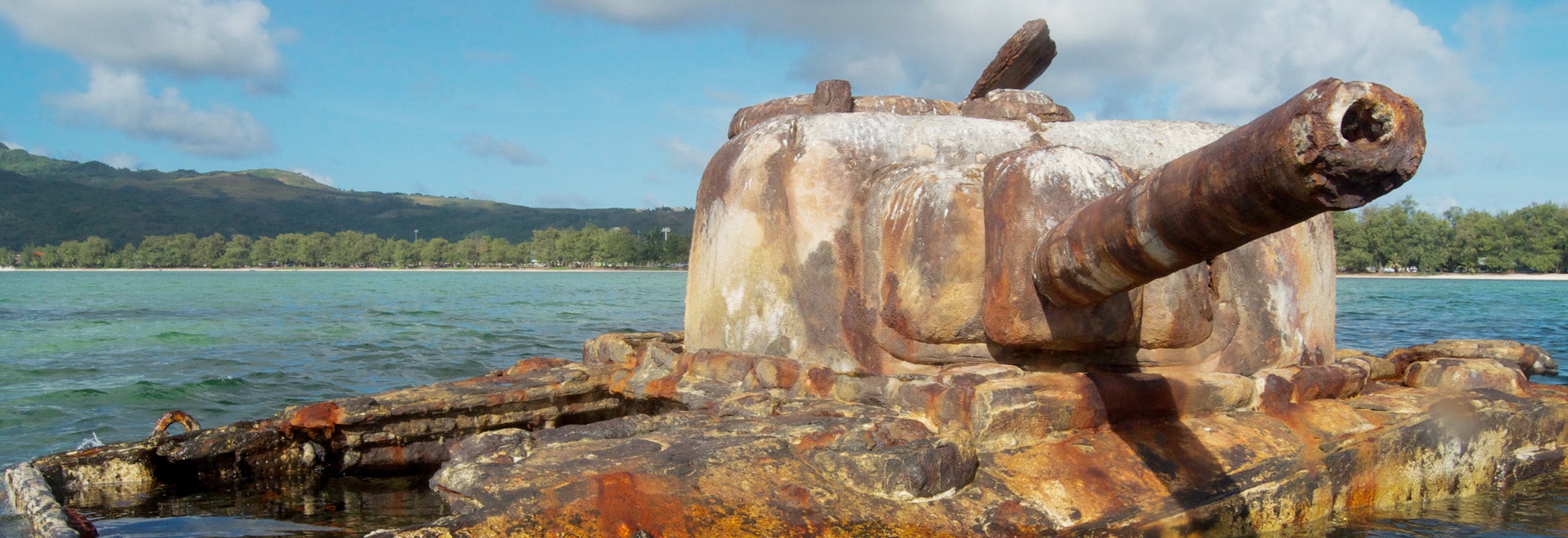ECU/DPAA Partnership
The Defense Prisoner of War/Missing in Action Accounting Agency’s (DPAA) mission is to provide the fullest possible accounting for U.S. missing service personnel to their families and the nation. Since 2017, East Carolina University’s Program in Maritime Studies has been partnering with the DPAA to conduct field missions and to house Research Partner Fellows as part of DPAA’s Hub and Spoke Program under the Partnerships and Innovations Directorate.
FIELD MISSIONS
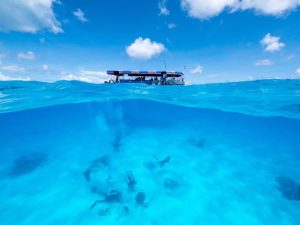
Joint Recovery Team excavates in Tanapag Harbor, Saipan in 2019.
As part of the larger DPAA-ECU partnership, the Program in Maritime Studies has conducted underwater archaeological field activities in support of the accounting mission. Such fieldwork involves the investigation, correlation, excavation, and recovery of sites associated with losses of past U.S. conflicts. This work requires ECU to understand and operate within the confines of forensic archaeological protocols of DPAA, contribute new and innovative techniques, and develop additional partners by which DPAA can improve upon and increase their mission results. ECU has undertaken several missions in both Europe and the Pacific which incorporate innovative technologies, adaptive applications, specialized training, and community partnerships.
2017 – Montalto, Italy
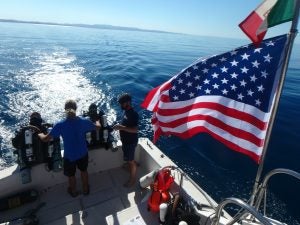
The team prepares to investigate the site of an U.S. Army Air Force bomber off Montalto, Italy in 2017.
In the fall of 2017, Drs. Jason Raupp (PI) and Jennifer McKinnon (co-PI) jointly led a team of researchers from East Carolina University, National Oceanic and Atmospheric Administration (NOAA), and National Park Service’s Submerged Resource Center to perform an underwater archaeological investigation of a U.S. Army Air Forces B-24H Liberator Heavy Bomber. The bomber, with its crew of 10, was shot down near Montalto, Italy in 1944. During the survey of the area, the team used acoustic imagery technology and photogrammetric survey to record the scattered wreckage and create a 3D model of the site. The combination of high-definition photogrammetric models, acoustic imagery, and related virtual documentation minimized the time spent manually recording sites, and the resulting dataset provided critical planning information, which assists decisions for future recovery efforts.
2018 – Morgo, Italy
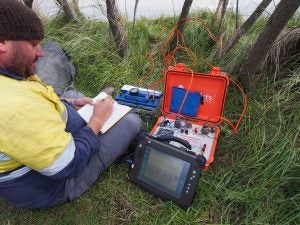
Dr. Ian Moffat uses ERT during the 2018 investigation in Morgo, Italy.
In February 2018, Drs. Jennifer McKinnon (PI) and Nathan Richards (co-PI) jointly led a team of US archaeologists, Italian archaeologists (Dr. Massimiliano Secci and Dr. Alberto Lezziero), and an Australian geoarchaeologist (Dr. Ian Moffat) in an effort to assist DPAA with recovery efforts of the lost crew of a B-24H in Morgo, Italy. The team applied waterborne and terrestrial ground-penetrating radar, electrical resistivity tomography (ERT), and metal detection at the site to map the disarticulated wreckage of the aircraft. Preliminary investigations of the site reveal a complex and highly disturbed context with years of post-crash impact through aquaculture farming and recreational hunting. Nevertheless, it is hoped that the characterization efforts of the project will support future missions for possible recoveries.
2018 – Saipan, ECU Summer Field School
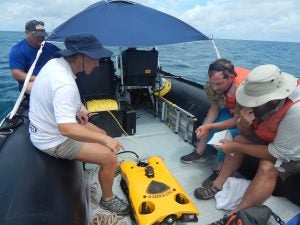
The 2018 ECU summer field school team prepares to deploy a Remotely-Operated Vehicle (ROV).
In partnership with the Naval Information Warfare Systems Command (NAVWAR), the Program in Maritime Studies held their 2018 summer field school as a DPAA-oriented mission to examine an already-known Avenger site and search for other aircraft losses in Tanapag Harbor, Saipan. Led by Drs. Jennifer McKinnon (PI) and Nathan Richards (co-PI), students explored sites using side scan sonar surveys, remotely operated vehicle target testing, diver/snorkel ground-truth target testing using visual and metal detection inspections, and archaeological survey and mapping. Their investigations resulted in extensively recording the Avenger site and locating sites such as aircraft wreckage, landing craft, shipwrecks, anchors, moorings, and other WWII-related debris. ECU’s 2018 summer field school provided a major step towards understanding the aftermath of the Battle of Saipan by identifying World War II remnants in Tanapag Harbor.
To learn more about ECU Program in Maritime Studies’ 2018 summer field school, please visit:
- Graduate Students’ Work in Saipan Could Help With Recovery of Servicemen MIA After WWII
- Graduate Students Learning to Become Better Archaeologists, Divers on Saipan Trip
- Maritime Students go from Surveying WWII Sites Underwater to Local Outreach
- Abroad in Saipan: Same Field School, Different Perspectives
2018 – Saipan, Joint Recovery Team
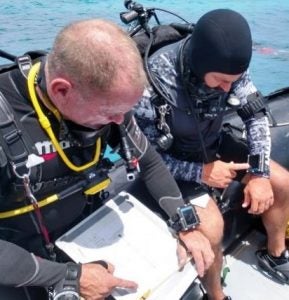
The Joint Recovery Team prepares to dive a target in Saipan, 2018.
Immediately following the summer field season in 2018, the Program partnered with Task Force Dagger Foundation (TFDF) and Florida Public Archaeology Network (FPAN) to form the Joint Recovery Team (JRT). The JRT’s goal was to establish and undertake a maritime heritage education program for wounded Special Operations Veterans through World War II archaeological investigations in Tanapag Harbor, Saipan. The JRT conducted diver/snorkel ground-truth target testing using visual and metal detection inspections, and archaeological survey and mapping. The JRT searched and documented 82 targets, one of which was recommended for future investigation.
To see a video of the Joint Recovery Team’s arrival and training in Saipan, please view:
To learn more about the Joint Recovery Team’s 2018 mission, please visit:
- Task Force Dagger and ECU team up to explore underwater WWII sites
- Task Force Dagger Foundation, ECU partner to provide rehabilitation diving for veterans
- A New Mission Provides Healing Opportunities
2019 – Saipan, Joint Recovery Team
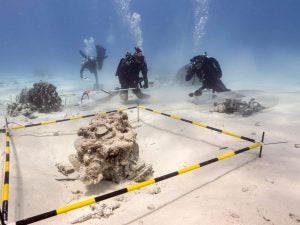
The Joint Recovery Team excavates a unit during the 2019 investigations in Saipan.
With the success of 2018 fieldwork, the Joint Recovery Team (JRT) returned to Saipan in 2019 to continue archaeological investigations of WWII-related aircraft targets. The team conducted metal detection surveys, archaeological survey and mapping, and test excavations on one of the sites found during the 2018 season. This site was identified as a US Grumman F6F Hellcat lost during WWII. In addition, the JRT also conducted a search for B-29 Superfortress Joltin’ Josie off Isley Field. Developed as a long-range bomber, Joltin’ Josie departed Isley Field for Tokyo on 1 April 1945 but burst into flames shortly after takeoff. The eleven crew members and one passenger on board remain unaccounted for.
To read more about the Joint Recovery Team, please read:
- The journey home: Recovering self and those who gave all
- Wounded Veterans in Parks and the Joint Recovery Team: American Veterans in Underwater Archaeology
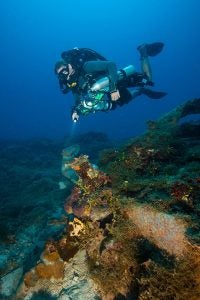
Dive Safety Offer Mark Keusenkothen uses a closed circuit rebreather to investigate a propeller during the 2019 Kwajalein project.
2019 – Kwajalein, Marshall Islands
In the fall of 2019, Drs. Jason Raupp (PI) and Jennifer McKinnon (co-PI) partnered with Professional Diving Services (PDS), ECU’s Coastal Studies Institute, Kwajalein MIA Project (KMP), Bureau of Ocean Energy Management (BOEM), and St. Augustine Lighthouse & Maritime Museum’s Lighthouse Maritime Archaeology Program to conduct archaeological investigations on sites at Kwajalein Atoll, Marshall Islands. The primary focus of the project was the investigation of a Consolidated PB2Y-5R Coronado. The depth at the crash site of Coronado warranted the use of three different types of diving technologies: surface supplied diving rigs (SSBA), closed circuit rebreathers (CCR), and open circuit SCUBA. Archaeologists conducted excavations, visual diver surveys, photographic documentation, site inspection and mapping.
2022 – Saipan, Joint Recovery Team
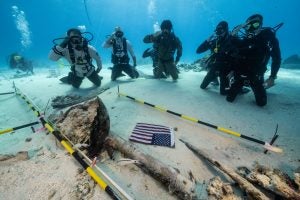
TFDF Veteran divers salute the site and fallen as we close it down for the season.
The Joint Recovery Team (JRT) returned to Saipan in 2022 to continue archaeological investigations on a US Grumman F6F Hellcat lost during WWII. Several more units were excavated on site with all material evidence recovered being transferred to the DPAA lab in Hawaii for analysis. The mission saw some returning TFDF veterans as well as some new participants. Plans for a 2023 mission are in the works with the hopes of closing out the site.
To read more about the Joint Recovery Team, please read:
2022 – Saipan, Innovation Project
DPAA is developing innovation projects by bringing together experts with advanced technology and knowledge that may contribute to the success and efficiency of its missions. ECU was part of such an innovation project in spring 2022, when it worked with researchers from Woods Hole Oceanographic Institute and University of Wisconsin’s Biotechnology Center to test methods in utilizing eDNA to detect traces of human genetic material left behind in seafloor sediments and the water column. Having located, mapped, and researched several aircraft over the last decade in Saipan, program faculty were a critical component for developing the project and providing support. Graduate students and faculty led the two-week project to support the innovation.
To read more about the Joint Recovery Team, please read:
RESEARCH PARTNER FELLOW
In addition to conducting field missions as part of the ECU-DPAA partnership, the Program in Maritime Studies is a member of the DPAA’s Hub and Spoke Program. The Hub and Spoke Program consists of a network of academic and educational institutions that partner with the DPAA to support their mission. Institutions house Research Partner Fellows from a variety of academic backgrounds, including history, archaeology, and genealogy. ECU hosts a two-year Research Partner Fellow who conducts historical and archival research and geospatial analysis. Research Partner Fellows collaborate with one another to conduct projects. The current Research Partner Fellow is Mr. Joel Cook, who has been in the position since early 2022.
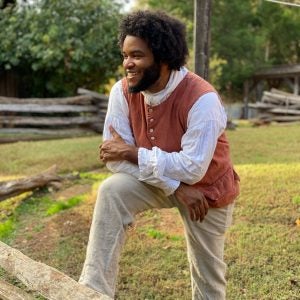
Joel Cook in period clothing at Old Salem.
Joel Cook holds an MA in Maritime Studies from East Carolina University and a BA in History from Fayetteville State University. He has experience as a historical researcher in topics ranging from the American Revolution to the Second World War, but his research focuses primarily on U.S. small combatant craft during the World Wars.
Prior to arriving at East Carolina he served as the Education Coordinator for Hidden Town at Old Salem Museum and Gardens, where he developed educational content and displays about the African and African American history of historic Salem, North Carolina.
Mr. Cook is currently involved in a project focused on US service personnel losses in Bungo Channel and will be teaching HIST3005 Battlefield Archaeology in spring 2023. The course draws on archaeological and historical approaches to reconstruct knowledge about past human conflicts. It covers a wide range of case studies from ancient and modern conflicts to domestic and international conflicts.
For more information about the Research Partner Fellow’s work, please view:
Encouraging Archaeological Diversity
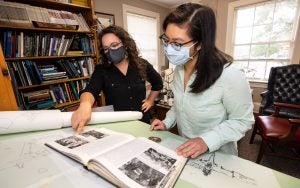
Dr. Jennifer McKinnon and former fellow Ms. Aleck Tan conduct research to support the DPAA mission. (Photo by Rhett Butler)
